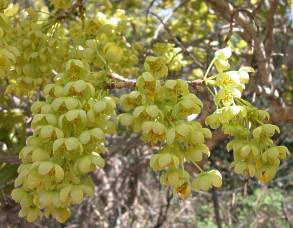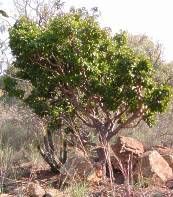Ochna pulchra
Ochna pulchra Hook.f.
Family: Ochnaceae
Common names: peeling plane, peeling-bark ochna (Eng.); lekkerbreek (Afr.); monyelewyele (Tswana); monamane, mopha (Northern Sotho); musuma, murambo, tshithothonya ( Venda ); nzololo (Tso)
SA Tree No: 483
Introduction
This species is better known by its Afrikaans name, lekkerbreek. This is most probably one of South Africa 's most beautiful trees, but also one of the most difficult trees to grow.

Description
Description
It can be described as a shrublet or small to medium-sized tree of 3-8 m in height with a spreading crown. The stem of this beautiful tree is one of the most conspicuous features, with its greyish bark peeling off to reveal a smooth, yellowish or cream to milky white undersurface. This feature enables one to easily identify it from a distance. The younger branchlets are white and become greyish with age. The branchlets are brittle and no lenticels occur on them.

The leaves are simple, alternate and usually elliptic to oblanceolate in form with many veins. The spring foliage is in shades of fresh light green to bronze or red. In autumn the colour changes to brilliant coppery tints. Throughout the summer the leaves are glossy, often rather yellowish green. The leaves are hairless, the tips broadly tapering to almost rounded with the margins very slightly toothed towards the apex or tip. The leaves are born on short, stout stalks.

The flowers are sweetly scented, borne in many-flowered racemes and appear at the same time as the leaves. They are pale yellow or greenish yellow, in spring, (August-November), with petals falling early in the season.

The fruit is surrounded by pink to reddish persistent and enlarged sepals, giving it a flower-like appearance. The fruit comprises 1-3 separate, kidney-shaped carpels, green in colour then turning black as they ripen. This creates a strikingly attractive effect. The fruit matures in early summer.
Conservation Status
Status
Least Concern (LC).

Distribution and habitat
Distribution description
This tree was first collected on the Magaliesberg in 1841, but occurs from northern Zimbabwe, into Zambia, westwards towards Botswana, via the Caprivi Strip into Namibia. In South Africa it can be found in the northern part of Gauteng, Limpopo and North-West.
Ochna pulchra grows in open woodland and bush, and often found in Sour Veld, in sandy soils (it is common on dunes in the northern Kalahari). It is common on quartzite or granite hills, mostly on the northern side of koppies.
Derivation of name and historical aspects
History
The word Ochna was derived from the Greek word Ochne for the wild pear. Linnaeus thought that the leaves somewhat resembled that of the wild pear. The specific name pulchra, a Latin word, means beautiful, which is very apt for this tree.
The common name lekkerbreek is thought to refer to the brittleness of the branches.

Ecology
Ecology
Some bird species eat the fruit.
Uses
Use
It is said that the pulp of the fruit is edible, but the seeds are poisonous. According to Palmer & Pitman (1972), the Bushmen roasted the green fruit. The ripe ones are high in fat content. It is boiled in water and the fat skimmed off the surface. This is then eaten or used to polish iron. The fat is also suitable for the production of candles and soap, although the greenish brown oil is unpleasant-smelling.
The wood is pale brown or light reddish, soft and grained with a curious papery feel when planed smooth. It is only used for small ornaments and in Namibia arrows are made from the stems.
Growing Ochna pulchra
Grow
This plant is very difficult to grow. Very fresh seed must be collected and sown immediately in soil collected from the local area. It is also said that seed must be collected just before they turn totally black. Seeds seem to be parasitized often. Seedlings grow best planted out as soon as possible and thereafter they grow quickly.
Another very attractive species, more commonly found in gardens, is Ochna serrulata.
References
- Coates Palgrave, M. 2002. Keith Coates Palgrave Trees of southern Africa , edn 3. Struik, Cape Town .
- Jackson , W.P.U. 1990. Origins and meanings of names of South African plant genera . University of Cape Town , Rondebosch.
- Jeppe, B. 1974. Trees and shrubs of the Witwatersrand . Witwatersrand University , Johannesburg .
- Joffe, P. 1993. Die tuinier se gids tot Suid-Afrikaanse plante . Delos, Cape Town .
- Palmer, E. & Pitman, N. 1972. Trees of southern Africa . Balkema, Cape Town .
- Van Wyk, B. & Van Wyk, P. 1997. Field guide to trees of southern Africa . Struik, Cape Town .
- Van Wyk, B.,Van Wyk, P. & Van Wyk, B-E. 2000. Photographic guide to the trees of southern Africa . Briza Publications, Pretoria .
Credits
Karin Behr
Pretoria National Botanical Garden
June 2005
Plant Attributes:
Plant Type: Shrub, Tree
SA Distribution: Gauteng, Limpopo, Mpumalanga, North West
Soil type: Sandy, Loam
Flowering season: Spring
PH: Acid, Neutral
Flower colour: Yellow
Aspect: Full Sun
Gardening skill: Challenging
Special Features:
Horticultural zones











Rate this article
Article well written and informative
Rate this plant
Is this an interesting plant?
Login to add your Comment
Back to topNot registered yet? Click here to register.